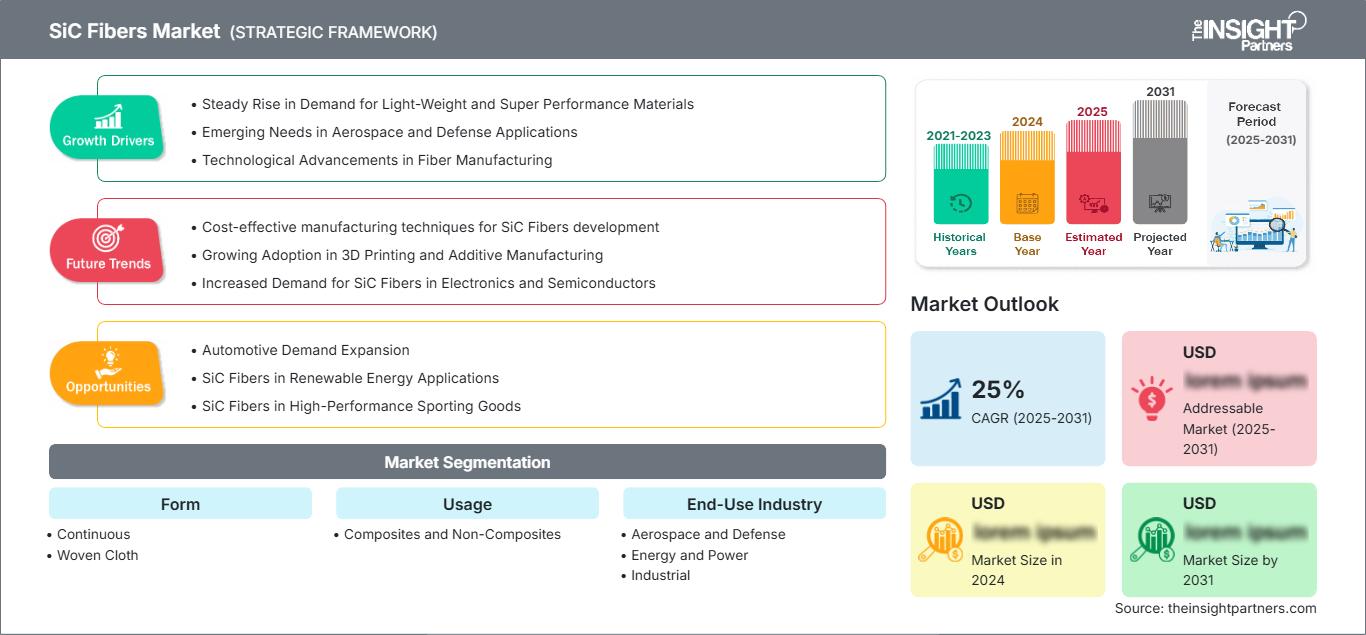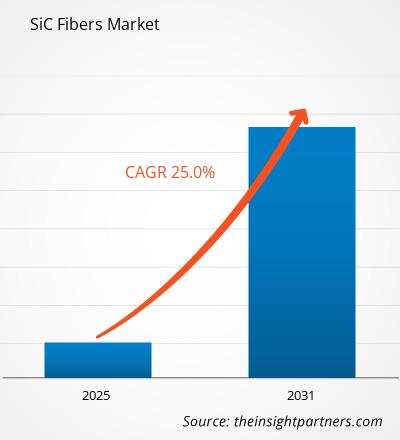Se espera que el tamaño del mercado de fibras de Sic alcance los US$ 3.57 mil millones para 2031. Se anticipa que el mercado registre una CAGR del 26,2% durante 2025-2031.
El mercado de fibras de SiC abarca el análisis por forma (continua, tejido y otras), uso (compuestos y no compuestos), industria de uso final (aeroespacial y defensa, energía y electricidad, industrial y otras), y geografía (Norteamérica, Europa, Asia Pacífico, Oriente Medio y África, y Sudamérica y Centroamérica). Las fibras de SiC se componen principalmente de moléculas de carburo de silicio, con un diámetro que generalmente oscila entre 5 µm y 50 µm. Su capacidad para soportar altas temperaturas, menor expansión térmica, menor densidad, mayor durabilidad oxidativa, menor permeabilidad, bajo peso, mayor resistencia y mejor conductividad térmica son las propiedades clave de las fibras de SiC que contribuyen a su popularidad en los sectores aeroespacial y de defensa, energía y electricidad, e industrial.
Propósito del Informe
El informe "Mercado de Fibras de SiC" de The Insight Partners busca describir el panorama actual y el crecimiento futuro, los principales factores impulsores, los desafíos y las oportunidades. Esto proporcionará información a diversas partes interesadas del negocio, como:
- Proveedores/fabricantes de tecnología: Para comprender la dinámica cambiante del mercado y conocer las oportunidades potenciales de crecimiento, lo que les permitirá tomar decisiones estratégicas informadas.
- Inversores: Realizar un análisis exhaustivo de tendencias respecto a la tasa de crecimiento del mercado, las proyecciones financieras del mercado y las oportunidades que existen en toda la cadena de valor.
- Órganos reguladores: Regular las políticas y las actividades policiales en el mercado con el objetivo de minimizar el abuso, preservar la confianza de los inversores y defender la integridad y estabilidad del mercado.
Formulario de segmentación del mercado de fibras de SiC
- Continuo
- Tela tejida
Uso
- Compuestos y no compuestos
Industria de uso final
- Aeroespacial y Defensa
- Energía y potencia
- Industrial
Geografía
- América del norte
- Europa
- Asia-Pacífico
- América del Sur y Central
- Oriente Medio y África
Obtendrá personalización en cualquier informe, sin cargo, incluidas partes de este informe o análisis a nivel de país, paquete de datos de Excel, así como también grandes ofertas y descuentos para empresas emergentes y universidades.
Mercado de fibras de SiC: Perspectivas estratégicas

-
Obtenga las principales tendencias clave del mercado de este informe.Esta muestra GRATUITA incluirá análisis de datos, desde tendencias del mercado hasta estimaciones y pronósticos.
Factores que impulsan el crecimiento del mercado de fibras de SiC
- Aumento constante de la demanda de materiales ligeros y de alto rendimiento: Las fibras de carburo de silicio (SiC) se distinguen por sus propiedades mecánicas, como la resistencia a la tracción, la estabilidad térmica y la baja densidad. Por lo tanto, son adecuadas para aplicaciones aeroespaciales, automotrices y de defensa. La creciente demanda de materiales ligeros y de alto rendimiento en estos sectores, especialmente para aplicaciones de alta temperatura, ha impulsado el rápido surgimiento de las fibras de SiC como uno de los componentes materiales más importantes en los compuestos avanzados.
- Necesidades emergentes en aplicaciones aeroespaciales y de defensa: Estas fibras de SiC cumplirían eficazmente con las especificaciones de componentes de bajo peso y alta resistencia para aplicaciones como piezas de motores y álabes de turbinas en los sectores aeroespacial y de defensa. El enfoque actual en la mejora de la eficiencia del combustible, junto con la reducción de peso en la aviación, continúa aumentando su dependencia de las industrias que requieren fibras de SiC para aplicaciones de alta temperatura y alta tensión, y, por consiguiente, del mercado.
- Avances tecnológicos en la fabricación de fibra: Entre estos cambios se incluye el desarrollo de métodos más eficaces y económicos para producir fibra de SiC. Por lo tanto, el material se vuelve más accesible. Esto significa que, con la nueva tecnología y los menores costos de producción, la fibra de SiC pronto podría resultar comercialmente viable para muchas de sus aplicaciones potenciales, lo que impulsará el crecimiento del mercado y generará nuevas oportunidades en diversas áreas.
Tendencias futuras del mercado de fibras de SiC
- Técnicas de fabricación rentables para el desarrollo de fibras de SiC: Se prevé un aumento en la demanda de fibras de SiC, lo que impulsará mejoras en el proceso de producción para obtener productos de alta calidad a bajo costo. Esto implicará optimizaciones basadas en el ahorro de costos en técnicas como la infiltración química de vapor (CVI) y la deposición química de vapor por láser (LCVD), lo que reducirá el precio de los productos de fibra de SiC para una amplia gama de aplicaciones comerciales, desde la automoción hasta la energía y la industria aeroespacial.
- Creciente adopción en la impresión 3D y la fabricación aditiva: Las fibras de SiC se utilizarán cada vez más en la industria de la impresión 3D, especialmente para piezas de alto rendimiento. Cuanto más se desarrolle la tecnología en la fabricación aditiva, mayor será la demanda de fibras de SiC para la construcción de estructuras complejas, ligeras y muy duraderas. Por ello, su uso se intensifica en aplicaciones aeroespaciales, automotrices y de defensa, ya que en estas aplicaciones la tolerancia y la resistencia del material son las más exigentes.
- Aumento de la demanda de fibras de SiC en electrónica y semiconductores: La revolución del carburo de silicio en la electrónica, especialmente en semiconductores, está abriendo nuevas fronteras para las fibras de SiC. Estas fibras poseen excelentes propiedades de conducción térmica y resistencia a altas tensiones, por lo que son ideales para aplicaciones en electrónica avanzada, sistemas de energía y redes eléctricas. Además, la introducción de dispositivos electrónicos de nueva generación impulsará el crecimiento en este sector.
Oportunidades de mercado de las fibras de SiC
- Expansión de la demanda automotriz: A medida que la industria automotriz avanza rápidamente hacia el futuro de los vehículos eléctricos (VE) y la reducción de peso, el SiC presenta un gran potencial. El uso de fibras de SiC en componentes de motores eléctricos, baterías y sistemas de gestión térmica puede resultar muy atractivo y útil para mejorar el rendimiento y la eficiencia de los vehículos eléctricos. Los fabricantes están explorando las fibras de SiC debido al alto rendimiento y la eficiencia energética de los vehículos, demandados por el creciente mercado.
- Fibras de SiC en aplicaciones de energías renovables: La fabricación de componentes más eficientes y duraderos para turbinas y sistemas eléctricos se verá impulsada por las fibras de SiC, en consonancia con el auge de las tecnologías de energías renovables, como la solar y la eólica. Gracias a su alta conductividad térmica, resistencia al desgaste y excelente resistencia en situaciones extremas, las fibras de SiC son ideales para mejorar el rendimiento en aplicaciones de energías renovables.
- Fibras de SiC en artículos deportivos de alto rendimiento: La introducción de estas fibras en la producción de equipamiento deportivo de alto rendimiento, como bicicletas, cascos y equipos de protección, es una de las aplicaciones emergentes. Su ligereza, robustez y resistencia al impacto podrían mejorar la seguridad y el rendimiento del equipamiento deportivo. Esto también impulsaría una mayor diversificación de las fibras de SiC en segmentos no tradicionales.
Perspectivas regionales del mercado de fibras de SiC
Los analistas de The Insight Partners han explicado detalladamente las tendencias regionales y los factores que influyen en el mercado de fibras de SiC durante el período de pronóstico. Esta sección también analiza los segmentos y la geografía del mercado de fibras de SiC en Norteamérica, Europa, Asia Pacífico, Oriente Medio y África, y Sudamérica y Centroamérica.
Alcance del informe de mercado de fibras de SiC
| Atributo del informe | Detalles |
|---|---|
| Tamaño del mercado en 2024 | XX mil millones de dólares estadounidenses |
| Tamaño del mercado en 2031 | 3.570 millones de dólares estadounidenses |
| CAGR global (2025-2031) | 26,2% |
| Datos históricos | 2021-2023 |
| Período de pronóstico | 2025-2031 |
| Segmentos cubiertos |
Por formulario
|
| Regiones y países cubiertos |
América del norte
|
| Líderes del mercado y perfiles de empresas clave |
|
Densidad de los actores del mercado de fibras de SiC: comprensión de su impacto en la dinámica empresarial
El mercado de fibras de SiC está creciendo rápidamente, impulsado por la creciente demanda del usuario final debido a factores como la evolución de las preferencias de los consumidores, los avances tecnológicos y un mayor conocimiento de los beneficios del producto. A medida que aumenta la demanda, las empresas amplían su oferta, innovan para satisfacer las necesidades de los consumidores y aprovechan las tendencias emergentes, lo que impulsa aún más el crecimiento del mercado.

- Obtenga una descripción general de los principales actores clave del mercado de fibras de SiC
Puntos clave de venta
- Cobertura integral: el informe cubre exhaustivamente el análisis de productos, servicios, tipos y usuarios finales del mercado de fibras de SiC, proporcionando un panorama holístico.
- Análisis de expertos: el informe se compila con base en el conocimiento profundo de expertos y analistas de la industria.
- Información actualizada: El informe asegura relevancia comercial debido a su cobertura de información reciente y tendencias de datos.
- Opciones de personalización: este informe se puede personalizar para satisfacer los requisitos específicos del cliente y adaptarse adecuadamente a las estrategias comerciales.
Por lo tanto, el informe de investigación sobre el mercado de fibras de SiC puede ayudar a descifrar y comprender el panorama de la industria y sus perspectivas de crecimiento. Si bien existen algunas preocupaciones válidas, las ventajas generales de este informe tienden a superar las desventajas.
- Análisis histórico (2 años), año base, pronóstico (7 años) con CAGR
- Análisis PEST y FODA
- Tamaño del mercado, valor/volumen: global, regional y nacional
- Industria y panorama competitivo
- Conjunto de datos de Excel
Informes recientes
Testimonios
Razón para comprar
- Toma de decisiones informada
- Comprensión de la dinámica del mercado
- Análisis competitivo
- Información sobre clientes
- Pronósticos del mercado
- Mitigación de riesgos
- Planificación estratégica
- Justificación de la inversión
- Identificación de mercados emergentes
- Mejora de las estrategias de marketing
- Impulso de la eficiencia operativa
- Alineación con las tendencias regulatorias






















 Obtenga una muestra gratuita para - Mercado de fibras de SiC
Obtenga una muestra gratuita para - Mercado de fibras de SiC